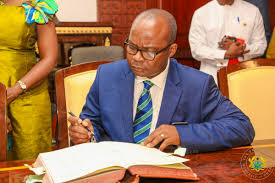
The Governor of Bank of Ghana (BoG), Dr Abdul Nashiru Issahaku has hinted that it intends to discourage Microfinance Institution (MFI) operators from setting up sophisticated branches using depositors’ funds in the country.
According to him, as at January 2017 there were 557 MFIs operating as licensed institutions in Tiers II and III categories. But the number of reporting Microfinance Institutions (MFIs) was 386 with a market share of 1.8% of the total assets of the Banking industry.
He made this made known at the Monetary Policy Committee (MPC) press conference in Accra on Monday, this week.
Dr Issahaku added that the Bank intends to consider the creation of an Apex Body to assist in the supervision of licensed MFIs operations in the country.
Bank of Ghana also intends to intensify the level of financial literacy at the micro level for both practitioners and their clients; establish an effective and efficient call centre as part of the consumer protection strategies; set up resolution mechanism to deal with failed MFIs, he stated.
“The Bank has taken both regulatory and prudential measures in recent times to address some of the challenges in the microfinance sector, and as a measure has frozen licensing of new microfinance companies”.
Bank of Ghana is very concerned when the activities of some institutions lead to the loss of funds for the general public, according to Dr Issahaku.
In addition to questions asked after the presentation of the Monetary Policy Rate (MPR) statement on March 27, 2017 during the Monetary Policy Committee (MPC) press conference, below are responses to other questions/issues raised in various media discussions on the economy, with implications for monetary policy formulation:
- The cedi’s fall is attributed to weak “economic fundamentals” by some analysts. What is the state of play?
RESPONSE
The Ghana cedi came under some pressure due to strengthening US dollar, seasonal demand pressures and speculative activities but has since recovered.
- According to reports, the cedi has depreciated by 6 percent since January this year, which also coincides with the coming into office of a new government. Did the change in government have any impact on the cedi, especially with the way bargain-hunting investors behave these days?
RESPONSE
The depreciation of the cedi was on the back of strengthening dollar, seasonal demand factors and some speculative activities.
- We normally experience currency depreciation every first quarter, forcing some analysts to attribute this development to seasonal factors. However, the trend last year was different, compared to the 3 previous years, with the currency fairly holding firm against the US dollar. What was done differently last year?
RESPONSE
There are seasonal factors to an extent but these differ across years.
- What has been the benefit(s) of the forex auction introduced in November last year?
RESPONSE
- a) It provided an additional vehicle for intermediation to offload the cocoa proceeds to the banks.
- There was relative stability in the forex market for most part of last year but in the last two months things changed, coinciding with the introduction of the forex auction.
Did the auction have anything to do with the depreciation of the cedi then and possibly now? If yes, is the Bank going to continue with it (auction)?
RESPONSE
There were few issues with the pricing and allocations with implications for the exchange rate. However, there were other factors such as strengthening of the dollar, seasonal demand and speculative activities. The auction process is a transitional arrangement and currently on hold.
- Have the seasonal high demand for dollars by bulk oil distributors and other heavy importers to settle maturing bills had any effect on the currency’s depreciation?
RESPONSE
There is no seasonal bulk oil distributors demand…….the exchange rate depends on the forces of demand and supply.
- In the last two weeks, thankfully, it appears that the cedi is picking up in value as the slide has somewhat waned. How better or worst can it get?
RESPONSE
It can only get better. The monetary policy stance remains tight and along with the renewed confidence as a result of the clarity in policy direction by the government should support the currency.
- Attracting foreign investors into both the primary and secondary markets. • Many holders of forex are currently offloading onto the market and this is expected to continue.
- Do you think an incentive plan for institutions and individuals who bring in large quantities of dollars to the market will improve dollar flows to the banking sector to avoid the use of parallel forex traders, some of whom may even be illegal?
This could be a novelty in stabilising the cedi over the medium term.
RESPONSE
Yes, and we are exploring other measures while we encourage banks to pay higher interest on FX deposits. As long as regulatory and compliance issues are not bridged, both firms and individuals are encouraged to undertake legitimate businesses that should inure to the benefit of the country as a whole.
- Is BoG comfortable with the current fiscal posture vis-a-vis the impact on monetary policy going forward?
RESPONSE
Yes, the budget for 2017 envisages a return to the path of fiscal consolidation. This should complement monetary policy to achieve macroeconomic stability.
- Government is looking for higher growth this year against a tight monetary policy stance. How sure are you that you can maintain your position against pressure from fiscal authorities?
RESPONSE
Let me also emphasize that in addition to its price stability objective, the Bank also has a mandate to create an enabling environment for sustainable economic growth. In view of this, the Bank would continue to position its policy rate (MPR) after assessing the balance of risks of several factors (including but not limited to government fiscal operations) to inflation and output.
- We have witnessed a drop in inflation since it peaked in May last year. What are the main drivers for the disinflation?
RESPONSE
The decline in inflation was largely underpinned by tight monetary policy stance, relative stability in the exchange rate, favourable base effects and recently lower food prices.
- What is the biggest threat to achieving monetary policy objectives this year?
RESPONSE
- Impact of tighter external financing conditions, • Volatile commodity prices and; • Unanticipated increases in administered prices.
- In the BoG’s assessment, to what extent would government’s decision to abolish some taxes, such as the one per cent special import levy and the 17.5 per cent VAT/NHIL on financial services, impact on monetary policy and the economy in general?
RESPONSE
Despite these tax reliefs, the overall stance of fiscal policy is one of fiscal consolidation which will support monetary policy’s efforts to deliver macro stability. It is, therefore, important to concentrate on the implications of the overall fiscal stance rather than on aspects of it.
- BoG’s Financial Stability Report shows that banks in Ghana registered a negative growth of 4.3 per cent for the 2016 financial 7 year, although this is an improvement from the negative growth of 7.4 per cent recorded during the same period of 2015, it is still a concern. What accounts for the consistent negative growth?
RESPONSE
On the contrary, the size of the banking industry has never registered a negative growth over the past decade. In 2016, which is the focus of your question for example, total assets of the banking industry rather grew nominally by 28.1% in 2016 relative to 23.2% in 2015.
In real terms, banks’ assets collectively grew by 11.06% at end-December 2016, improving on the 4.64% growth recorded at end-year 2015.
- The current government intends to continue with the Extended Credit Facility (EFC) programme with the IMF. What are some of the targets and structural reforms you anticipate or propose to be looked at? How are you (BoG) engaged or involved in that as far as monetary policy formulation is concerned?
RESPONSE
The government has indicated its intention to re-engage the FUND on aspects of the program. Until, this is done, all performance criteria and indicative targets and structural benchmarks in the existing program hold.
- For this year, government is aiming at achieving overall real GDP growth of 6.3 per cent; non-oil real GDP growth of 4.6 per cent; end- 8 year inflation of 11.2 percent; average inflation of 12.4 per cent and overall fiscal deficit of 6.5 per cent of GDP.
What would you say about this ambitious target, as some say, on monetary policy?
RESPONSE
We think the targets are realistic and achievable. The anticipated fiscal consolidation will support monetary policy to bring inflation down.
- How much revenue did the agriculture sector generate for the economy last year and how important is the sector to achieving stable prices?
RESPONSE
The Agriculture Sector contributed 3.6% of GDP [or GHS6.1 bn] in 2016. An improvement in production in this sector is likely to lower food prices and bring headline inflation down.
- There have been concerns in the banking community about some microfinance companies operating as if they were banks and therefore increasing their exposure. The concerns are that the development has led to the loss of funds?
Does BoG share these concerns? And what are the prudential controls in place to address this misnomer?
RESPONSE
As at January 2017 there were Five hundred and fifty-seven (557) MFIs operating as licensed institutions in Tiers II and III categories. The number of reporting Microfinance Institutions (MFIs) was 386 with a market share of 1.8% of the total assets of the Banking industry.
Bank of Ghana is very concerned when the activities of some institutions lead to the loss of funds for the general public. The Bank has taken both regulatory and prudential measures in recent times to address some of the challenges in the microfinance sector, and as a measure has frozen licensing of new microfinance companies.
Bank of Ghana also intends to: • Intensify the level of financial literacy at the micro level for both practitioners and their clients; • Establish an effective and efficient call centre as part of the consumer protection strategies; • Discourage MFI operators from setting up sophisticated branches using depositors’ funds; • Set up resolution mechanism to deal with failed MFIs and; • Consider the creation of an Apex Body to assist in the supervision of licensed MFIs.
- Are any changes (deterioration or improvement) expected in the trend of NPLs?
RESPONSE
Yes, as Government continues to honour its commitment to pay down the restructured energy-related SOEs debts, it is expected that banks’ non-performing loans will decline, with positive implications on the solvency of banks in the coming months.
- What’s the central bank’s monetary stimulus for this year?
RESPONSE
The Bank does not have specific stimulus in the year. What we do is to analyse the balance of risks to inflation and growth at any point in time and then appropriately position the key instrument – the policy rate (to deliver our mandate while ensuring growth is not unduly hampered).
- When you look at page 34 of the budget statement, the government wants the central bank to strengthen its inflation targeting regime and also pursue complementary monetary policy to promote monetary discipline. How does the Bank intend to achieve this?
RESPONSE
- By ensuring that the policies on lending to government are strictly upheld to avoid fiscal dominance to enhance credibility of our policies; • Continue to implement refinements to the operational framework with the view to enhance the effectiveness of transmission of monetary policies; • Enhance liquidity forecasting.
- According to the economic and financial data from the central bank, the cedi depreciated by 5 percent against the US dollar in March. Was it as a result of drop in interest rates in December, which pushed investors to move their investments from cedi denominated instruments to dollar denominated ones?
RESPONSE
The 5 percent depreciation was as of 23rd March, 2017. It is currently much lower (around 3.5 per cent) with the cedi still strengthening, which we expect to continue. The depreciation of the Ghana cedi against the dollar was mainly as a result of: • International currency realignments (strengthening dollar); • Seasonal demand factors; • Election related uncertainty and speculative activities; Treasury Bill auction rates are determined purely by the public sector borrowing requirements.
- The government has pegged end-year inflation at 11.2 per cent, what’s the Bank’s own projections…?
RESPONSE The end-year inflation target of 11.2 per cent is also the Bank’s end-year inflation target; and this is in line with our forecasts.
African Eye Report




